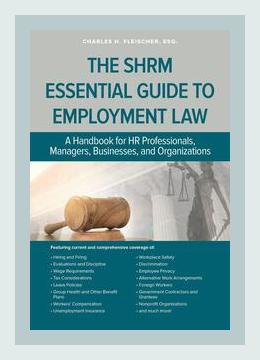Human Resources and Talent ManagementLabor Relations
Title: Employment Law and Human Resources
Author: Dean A. (Donny) Swanson
Year of Publication: 2017
Categories: Labor Relations
Introduction
“Employment Law and Human Resources” by Dean A. (Donny) Swanson from 2017 is a comprehensive guide aimed at HR professionals, managers, and decision-makers dealing with labor relations and employment laws. The book meticulously covers various aspects of employment law, offering actionable advice for navigating legal complexities. This summary encapsulates the essence of Swanson’s work, highlighting major points and practical actions one can take.
Chapter 1: Understanding Employment Law
Major Points:
- Historical Context: Swanson outlines the history of employment law, emphasizing significant milestones such as the Fair Labor Standards Act (FLSA) and the National Labor Relations Act (NLRA).
- Legal Framework: The book provides a thorough overview of federal and state legislations that impact employment relationships.
Actions to Take:
– Educate Yourself: Familiarize yourself with key legislation and historical contexts to better understand the current legal landscape.
– Maintain a Legal Handbook: Develop a company handbook that includes summaries of pertinent laws to ensure compliance.
Chapter 2: Hiring Practices and Legislation
Major Points:
- Non-discriminatory Hiring Practices: Discusses laws like Title VII of the Civil Rights Act, emphasizing the importance of fair hiring practices.
- Interview Guidelines: Provides steps to create unbiased interview questions compliant with EEOC regulations.
- Background Checks: Examines the legal constraints and best practices for conducting background checks on potential hires.
Actions to Take:
– Develop Non-Biased Job Descriptions: Ensure job postings are free from discriminatory language.
– Structured Interviews: Implement structured interview processes that adhere to legal guidelines.
– Conduct Legal Background Checks: Follow FCRA guidelines when conducting background checks and notify candidates accordingly.
Chapter 3: Wage and Hour Laws
Major Points:
- Minimum Wage Requirements: Details federal and state minimum wage laws.
- Overtime Regulations: Covers criteria for overtime pay under the FLSA.
- Break Periods: Explains mandatory break periods and meal times.
Actions to Take:
– Audit Payroll Systems: Regularly audit payroll systems to ensure compliance with wage laws.
– Educate Managers: Train managers on overtime eligibility and proper scheduling.
– Implement Clear Policies: Create written policies regarding work hours and breaks to prevent violations.
Chapter 4: Employee Benefits and Compensation
Major Points:
- Health Insurance Laws: Reviews the Affordable Care Act (ACA) and employer obligations.
- Retirement Benefits: Explains regulations surrounding retirement plans, such as ERISA.
- Bonuses and Incentives: Discusses how to legally structure employee bonuses and incentives.
Actions to Take:
– Provide ACA-Compliant Health Plans: Ensure that the health plans offered meet ACA criteria.
– Monitor Retirement Plans: Regularly review retirement plans to ensure compliance with ERISA.
– Transparent Bonus Structures: Develop clear and documented bonus structures to avoid discrimination claims.
Chapter 5: Workplace Safety and Health
Major Points:
- OSHA Regulations: Offers a comprehensive look at Occupational Safety and Health Administration (OSHA) standards.
- Reporting and Compliance: Details the necessary steps for incident reporting and compliance.
- Preventative Measures: Emphasizes the importance of workplace safety training and preventive measures.
Actions to Take:
– Conduct Regular Safety Audits: Engage in periodic safety inspections to ensure OSHA compliance.
– Develop a Reporting System: Implement a clear system for reporting and documenting safety incidents.
– Training Programs: Conduct regular safety training sessions for employees.
Chapter 6: Employee Rights and Privacy
Major Points:
- Privacy Laws: Examines employee privacy rights, including electronic monitoring and drug testing.
- Freedom of Expression: Discusses the balance between employee expression and company interests.
- Reasonable Accommodations: Reviews ADA requirements for providing accommodations to employees with disabilities.
Actions to Take:
– Create Privacy Policies: Develop transparent policies regarding electronic monitoring and data privacy.
– Respect Expression Rights: Encourage an inclusive environment while establishing clear guidelines on acceptable behavior and expression.
– Implement Accommodations: Ensure processes are in place to evaluate and provide reasonable accommodations.
Chapter 7: Unions and Collective Bargaining
Major Points:
- Union Formation: Details the legal procedure for union formation and the rights of workers.
- Negotiations: Offers strategies for effective collective bargaining.
- Dispute Resolution: Reviews mechanisms for resolving labor disputes, including mediation and arbitration.
Actions to Take:
– Support Union Relations: Maintain open communication with union representatives to foster a cooperative relationship.
– Training for Negotiations: Equip management teams with negotiation skills and legal knowledge to handle collective bargaining effectively.
– Implement Dispute Procedures: Establish clear, fair procedures for addressing and resolving disputes.
Chapter 8: Termination and Severance
Major Points:
- Legal Grounds for Termination: Identifies lawful reasons for terminating an employee, including performance issues and misconduct.
- Termination Procedures: Provides a step-by-step guide to legally sound termination processes.
- Severance Agreements: Discusses the elements and legalities involved in structuring severance packages.
Actions to Take:
– Document Performance Issues: Keep detailed records of performance issues and steps taken to address them.
– Follow Termination Protocols: Adhere to documented procedures when conducting terminations to mitigate legal risks.
– Draft Clear Severance Terms: Clearly outline severance terms and conditions in written agreements.
Chapter 9: Handling Discrimination and Harassment
Major Points:
- Anti-Discrimination Laws: Reviews Title VII, ADEA, ADA, and other anti-discrimination statutes.
- Harassment Policies: Emphasizes the importance of robust anti-harassment policies and training.
- Complaint Procedures: Provides guidelines for creating effective, legally compliant complaint handling procedures.
Actions to Take:
– Enforce Equal Opportunity Policies: Regularly update and enforce anti-discrimination policies.
– Train on Harassment: Conduct ongoing training to educate employees about harassment and discrimination.
– Set Up Reporting Mechanisms: Implement confidential reporting mechanisms for handling complaints efficiently.
Conclusion
Dean A. (Donny) Swanson’s “Employment Law and Human Resources,” published in 2017, serves as an essential guide for HR practitioners and managers navigating the complex landscape of employment laws. The book’s structured insights and examples, from hiring practices to termination protocols, offer practical steps to ensure compliance and build a legally sound and equitable workplace. By integrating these actions, organizations can better safeguard themselves against legal pitfalls and foster a positive work environment consistent with legal standards.
